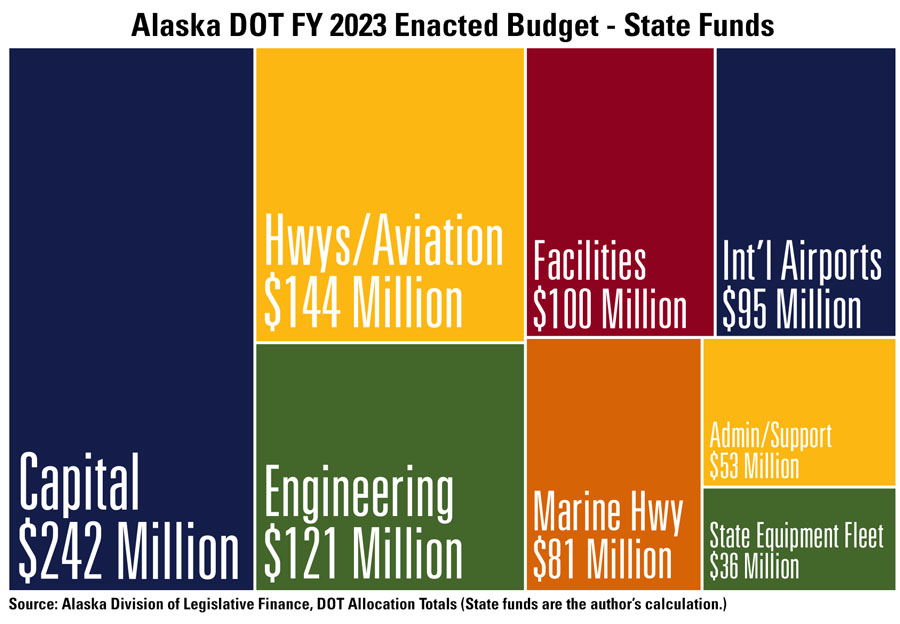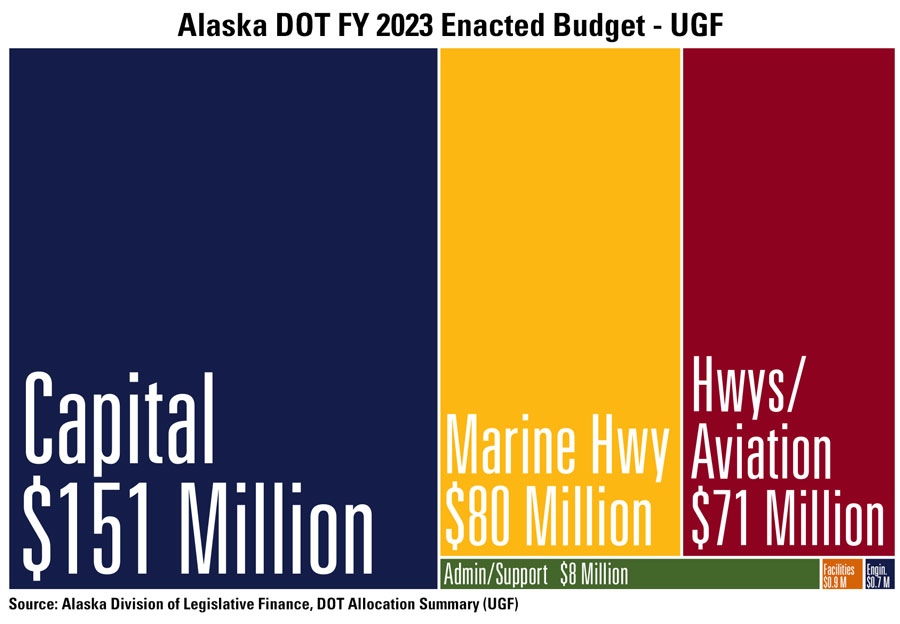Introduction
Alaska Policy Forum’s annual Budget Blocks are a simple, straightforward way to visualize how Alaska is spending its money and from which funds that money is coming. The budget blocks below are specifically for the Department of Transportation and Public Facilities (DOT). The size of each block corresponds to the amount allocated to each division of DOT in the operating and capital budgets. The larger the dollar amount, the larger the block. All of the numbers are taken straight from the FY 2023 Enacted Budget DOT allocation summaries provided to the public by the Alaska Division of Legislative Finance.
The operating budget covers ongoing operations and expenses for the State of Alaska, or the day-to-day running of the government and state programs. According to OMB, it is “annual appropriations covering ongoing operations. Appropriations are typically made for a fiscal year, with funds lapsing at the end of the fiscal year.”
Many projects undertaken by DOT were appropriated under the capital budget in FY 2023, such as highway construction projects, air quality reports, and additional funding for the Marine Highway System. In fact, general fund appropriations from the capital budget for DOT were over $170 million, while general funds from the total capital budget (which excludes federal funds) in FY 2021 were about $146 million. DOT’s capital appropriations in FY 2023 were $24 million more than the total capital budget was just two years prior. Due to federal matching requirements — when the federal government grants projects money, there is an expectation that the state match a certain amount to reach the full sum needed for the project — and the 2021 federal infrastructure bill, Alaska will be expected to cough up hundreds of millions more this coming fiscal year.
Descriptions:
- Division of Facilities Services (Facilities) – delivers, improves, and maintains facilities across the state
- Administration and Support (Admin/Support) – supports DOT&PF with administration
- Design, Engineering, and Construction (Engineering) – develops transportation and public facilities projects and constructs highways, airports, harbors, docks, and buildings
- State Equipment Fleet – acquire, maintain, and dispose of vehicles, equipment, and attachments for use by the executive branch agencies
- Highways, Aviation and Facilities (Hwys/Aviation) – operate, maintain, safeguard, and control the state’s infrastructure system of highways, airports, and harbors.
- International Airports (Int’l Airports) – operate and maintain the Ted Stevens Anchorage International Airport and the Fairbanks International Airport
- Marine Highway System (Marine Hwy) – provides transportation services and operates and maintains a network of infrastructure afloat and ashore
- Capital – capital budget appropriations
- Unrestricted General Fund (UGF) – Non-federal money with no statutory restrictions; the legislature has the discretion to spend this money however it chooses
- Designated General Fund (DGF) – Non-federal money that is statutorily designated for a specific purpose. According to the Alaska Division of Legislative Finance, “The legislature traditionally complies with designations, but may use these funds for any purpose at any time.”
- Other State Funds (Other) – Non-federal money that the legislature has limited discretion over
Budget Block One: Total Allocations
Total Allocations, including state and federal funds.

Budget Block Two: State Funds
State funds includes UGF, DGF, and Other state funds. This block compared to the first block gives viewers a perspective of which divisions rely most heavily on federal funds versus state funds.
Budget Block Three: Percentage of Funds
This graph shows which funds were appropriated for each DOT division. Five of seven DOT divisions were funded mostly through Other state fund appropriations, rather than general fund appropriations.
Budget Block Four: Undesignated General Funds
Undesignated General Funds, which has no statutory restrictions.


